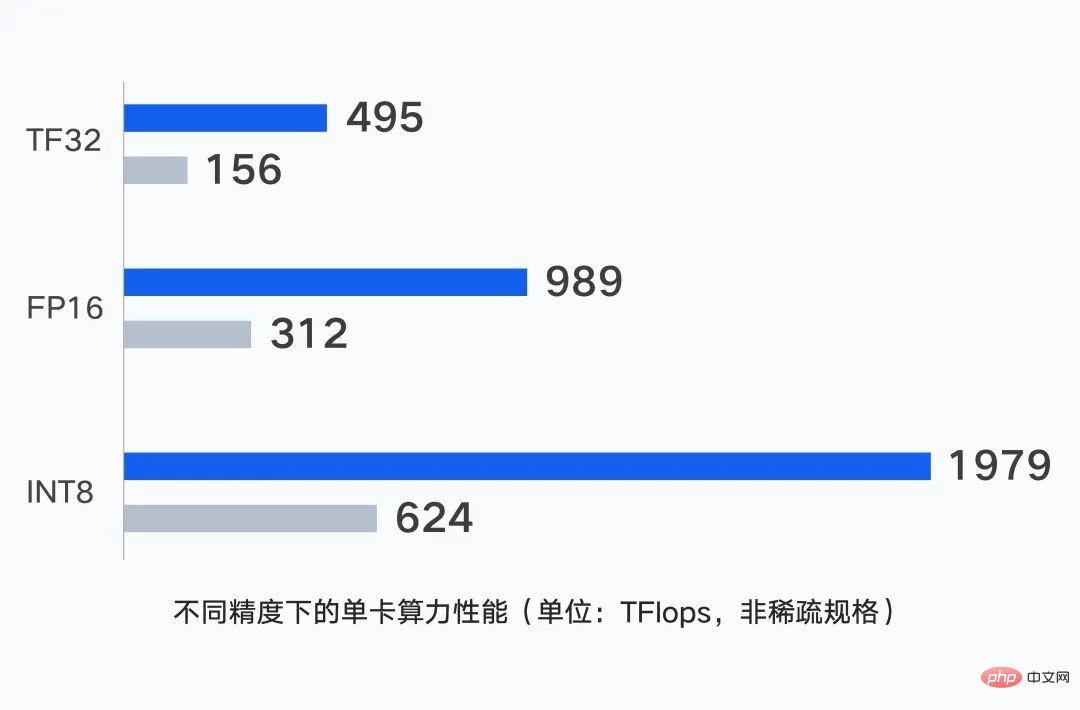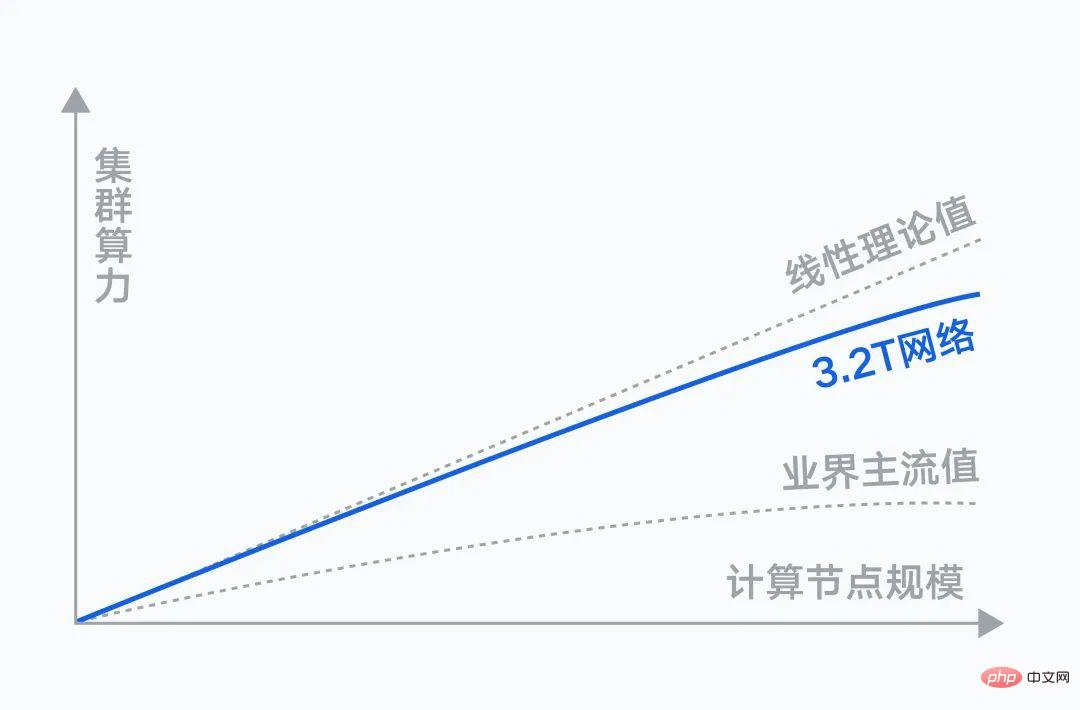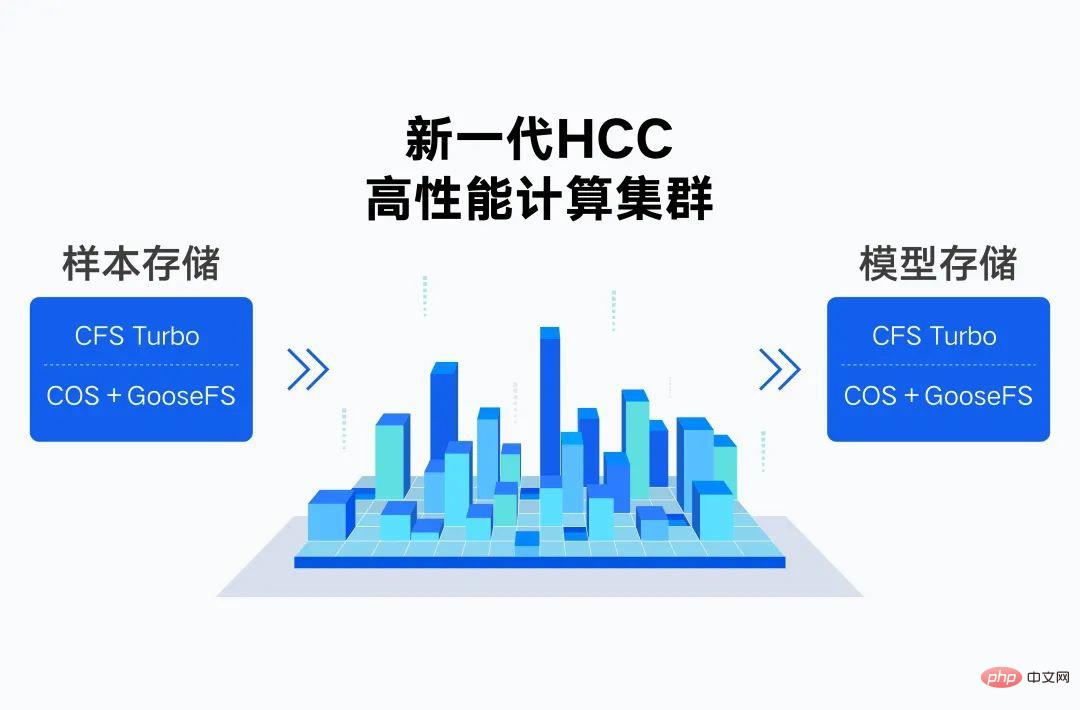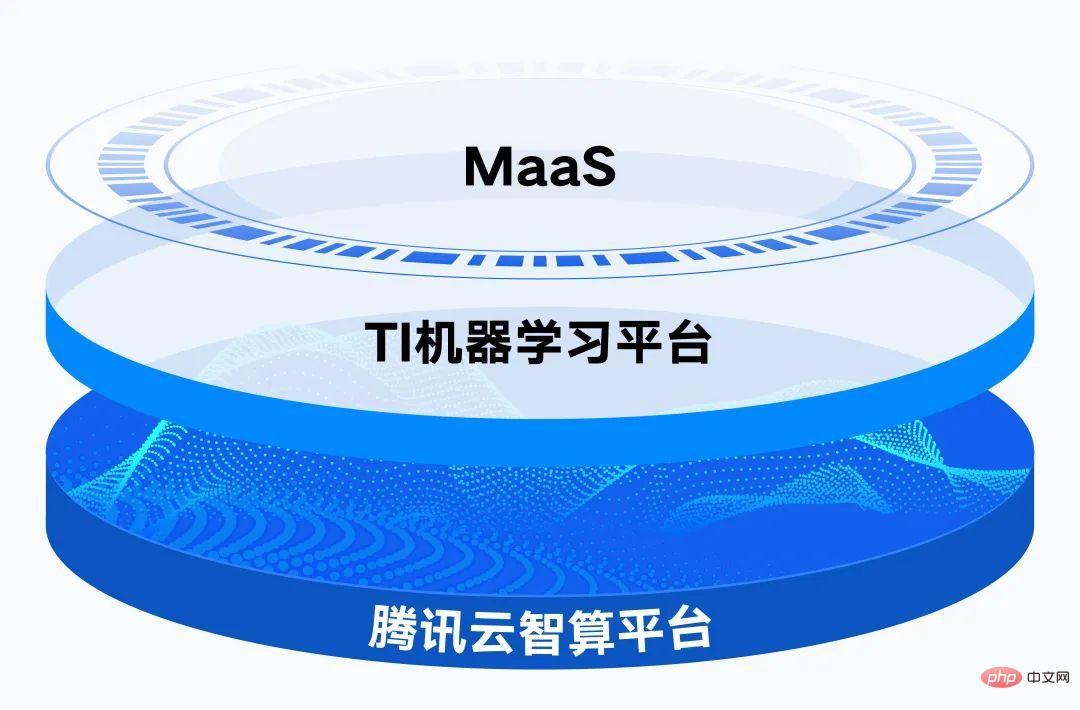 Technology peripherals
Technology peripherals
 AI
AI
 Tencent releases a new generation of super computing cluster: for large model training, performance increased by 3 times
Tencent releases a new generation of super computing cluster: for large model training, performance increased by 3 times
Tencent releases a new generation of super computing cluster: for large model training, performance increased by 3 times
The new generation HCC high-performance computing cluster uses the latest generation of Xinghai self-developed servers and is equipped with NVIDIA H800 Tensor Core GPU.
Tencent officials said that the cluster is based on self-developed network and storage architecture, bringing 3.2T ultra-high interconnect bandwidth, TB-level throughput capacity and tens of millions of IOPS. Actual measurement results show that the computing power performance of the new generation cluster is improved by 3 times compared with the previous generation.

In October last year, Tencent completed the training of the first large-scale AI model with one trillion parameters - the Hunyuan NLP large model. With the same data set, the training time is shortened from 50 days to 11 days. If based on a new generation cluster, the training time will be further reduced to 4 days.
At the computing level, server stand-alone performance is the basis of cluster computing power. The single GPU card of Tencent Cloud's new generation cluster supports output of up to 1979 TFlops of computing power under different precisions.
For large model scenarios, Xingxinghai’s self-developed server adopts a 6U ultra-high-density design, which is 30% higher than the industry’s supported shelf density; using the parallel computing concept, through the integrated design of CPU and GPU nodes, Improve single-point computing power performance to a higher level.

#At the network level, there are massive data interaction requirements between computing nodes. As the cluster scale expands, communication performance will directly affect training efficiency, requiring maximum collaboration between the network and computing nodes.
Tencent’s self-developed Xingmai high-performance computing network claims to have the industry’s highest 3.2T RDMA communication bandwidth. Actual measurement results show that equipped with the same number of GPUs, the 3.2T Xingmai network has a 20% increase in the overall computing power of the cluster compared to the 1.6T network.
At the same time, Tencent’s self-developed high-performance collective communication library TCCL is integrated into custom-designed solutions. Compared with the industry's open source collective communication library, it optimizes 40% load performance for large model training and eliminates training interruption problems caused by multiple network reasons.

At the storage level, during large model training, a large number of computing nodes will read a batch of data sets at the same time. It is necessary to shorten the data loading time as much as possible to avoid waiting for computing nodes.
Tencent Cloud’s self-developed storage architecture has terabyte-level throughput capabilities and tens of millions of IOPS, supporting storage needs in different scenarios. COS GooseFS object storage solution and CFS Turbo high-performance file storage solution fully meet the high performance, large throughput and massive storage requirements in large model scenarios.

In addition, the new generation cluster integrates Tencent Cloud’s self-developed TACO training acceleration engine, which performs a large number of system-level optimizations on network protocols, communication strategies, AI frameworks, and model compilation. Significantly save training tuning and computing power costs.
AngelPTM, the training framework behind Tencent’s Hunyuan large model, has also provided services through Tencent Cloud TACO to help enterprises accelerate the implementation of large models.
Through the large model capabilities and toolbox of Tencent Cloud TI platform, enterprises can conduct fine-tuned training based on industrial scenario data, improve production efficiency, and quickly create and deploy AI applications.

Relying on the distributed cloud-native governance capabilities, Tencent Cloud Intelligent Computing Platform provides 16 EFLOPS of floating-point computing power.
The above is the detailed content of Tencent releases a new generation of super computing cluster: for large model training, performance increased by 3 times. For more information, please follow other related articles on the PHP Chinese website!

Hot AI Tools

Undresser.AI Undress
AI-powered app for creating realistic nude photos

AI Clothes Remover
Online AI tool for removing clothes from photos.

Undress AI Tool
Undress images for free

Clothoff.io
AI clothes remover

Video Face Swap
Swap faces in any video effortlessly with our completely free AI face swap tool!

Hot Article

Hot Tools

Notepad++7.3.1
Easy-to-use and free code editor

SublimeText3 Chinese version
Chinese version, very easy to use

Zend Studio 13.0.1
Powerful PHP integrated development environment

Dreamweaver CS6
Visual web development tools

SublimeText3 Mac version
God-level code editing software (SublimeText3)

Hot Topics
 1387
1387
 52
52
 Bytedance Cutting launches SVIP super membership: 499 yuan for continuous annual subscription, providing a variety of AI functions
Jun 28, 2024 am 03:51 AM
Bytedance Cutting launches SVIP super membership: 499 yuan for continuous annual subscription, providing a variety of AI functions
Jun 28, 2024 am 03:51 AM
This site reported on June 27 that Jianying is a video editing software developed by FaceMeng Technology, a subsidiary of ByteDance. It relies on the Douyin platform and basically produces short video content for users of the platform. It is compatible with iOS, Android, and Windows. , MacOS and other operating systems. Jianying officially announced the upgrade of its membership system and launched a new SVIP, which includes a variety of AI black technologies, such as intelligent translation, intelligent highlighting, intelligent packaging, digital human synthesis, etc. In terms of price, the monthly fee for clipping SVIP is 79 yuan, the annual fee is 599 yuan (note on this site: equivalent to 49.9 yuan per month), the continuous monthly subscription is 59 yuan per month, and the continuous annual subscription is 499 yuan per year (equivalent to 41.6 yuan per month) . In addition, the cut official also stated that in order to improve the user experience, those who have subscribed to the original VIP
 Big model app Tencent Yuanbao is online! Hunyuan is upgraded to create an all-round AI assistant that can be carried anywhere
Jun 09, 2024 pm 10:38 PM
Big model app Tencent Yuanbao is online! Hunyuan is upgraded to create an all-round AI assistant that can be carried anywhere
Jun 09, 2024 pm 10:38 PM
On May 30, Tencent announced a comprehensive upgrade of its Hunyuan model. The App "Tencent Yuanbao" based on the Hunyuan model was officially launched and can be downloaded from Apple and Android app stores. Compared with the Hunyuan applet version in the previous testing stage, Tencent Yuanbao provides core capabilities such as AI search, AI summary, and AI writing for work efficiency scenarios; for daily life scenarios, Yuanbao's gameplay is also richer and provides multiple features. AI application, and new gameplay methods such as creating personal agents are added. "Tencent does not strive to be the first to make large models." Liu Yuhong, vice president of Tencent Cloud and head of Tencent Hunyuan large model, said: "In the past year, we continued to promote the capabilities of Tencent Hunyuan large model. In the rich and massive Polish technology in business scenarios while gaining insights into users’ real needs
 Context-augmented AI coding assistant using Rag and Sem-Rag
Jun 10, 2024 am 11:08 AM
Context-augmented AI coding assistant using Rag and Sem-Rag
Jun 10, 2024 am 11:08 AM
Improve developer productivity, efficiency, and accuracy by incorporating retrieval-enhanced generation and semantic memory into AI coding assistants. Translated from EnhancingAICodingAssistantswithContextUsingRAGandSEM-RAG, author JanakiramMSV. While basic AI programming assistants are naturally helpful, they often fail to provide the most relevant and correct code suggestions because they rely on a general understanding of the software language and the most common patterns of writing software. The code generated by these coding assistants is suitable for solving the problems they are responsible for solving, but often does not conform to the coding standards, conventions and styles of the individual teams. This often results in suggestions that need to be modified or refined in order for the code to be accepted into the application
 Can fine-tuning really allow LLM to learn new things: introducing new knowledge may make the model produce more hallucinations
Jun 11, 2024 pm 03:57 PM
Can fine-tuning really allow LLM to learn new things: introducing new knowledge may make the model produce more hallucinations
Jun 11, 2024 pm 03:57 PM
Large Language Models (LLMs) are trained on huge text databases, where they acquire large amounts of real-world knowledge. This knowledge is embedded into their parameters and can then be used when needed. The knowledge of these models is "reified" at the end of training. At the end of pre-training, the model actually stops learning. Align or fine-tune the model to learn how to leverage this knowledge and respond more naturally to user questions. But sometimes model knowledge is not enough, and although the model can access external content through RAG, it is considered beneficial to adapt the model to new domains through fine-tuning. This fine-tuning is performed using input from human annotators or other LLM creations, where the model encounters additional real-world knowledge and integrates it
 Seven Cool GenAI & LLM Technical Interview Questions
Jun 07, 2024 am 10:06 AM
Seven Cool GenAI & LLM Technical Interview Questions
Jun 07, 2024 am 10:06 AM
To learn more about AIGC, please visit: 51CTOAI.x Community https://www.51cto.com/aigc/Translator|Jingyan Reviewer|Chonglou is different from the traditional question bank that can be seen everywhere on the Internet. These questions It requires thinking outside the box. Large Language Models (LLMs) are increasingly important in the fields of data science, generative artificial intelligence (GenAI), and artificial intelligence. These complex algorithms enhance human skills and drive efficiency and innovation in many industries, becoming the key for companies to remain competitive. LLM has a wide range of applications. It can be used in fields such as natural language processing, text generation, speech recognition and recommendation systems. By learning from large amounts of data, LLM is able to generate text
 To provide a new scientific and complex question answering benchmark and evaluation system for large models, UNSW, Argonne, University of Chicago and other institutions jointly launched the SciQAG framework
Jul 25, 2024 am 06:42 AM
To provide a new scientific and complex question answering benchmark and evaluation system for large models, UNSW, Argonne, University of Chicago and other institutions jointly launched the SciQAG framework
Jul 25, 2024 am 06:42 AM
Editor |ScienceAI Question Answering (QA) data set plays a vital role in promoting natural language processing (NLP) research. High-quality QA data sets can not only be used to fine-tune models, but also effectively evaluate the capabilities of large language models (LLM), especially the ability to understand and reason about scientific knowledge. Although there are currently many scientific QA data sets covering medicine, chemistry, biology and other fields, these data sets still have some shortcomings. First, the data form is relatively simple, most of which are multiple-choice questions. They are easy to evaluate, but limit the model's answer selection range and cannot fully test the model's ability to answer scientific questions. In contrast, open-ended Q&A
 SOTA performance, Xiamen multi-modal protein-ligand affinity prediction AI method, combines molecular surface information for the first time
Jul 17, 2024 pm 06:37 PM
SOTA performance, Xiamen multi-modal protein-ligand affinity prediction AI method, combines molecular surface information for the first time
Jul 17, 2024 pm 06:37 PM
Editor | KX In the field of drug research and development, accurately and effectively predicting the binding affinity of proteins and ligands is crucial for drug screening and optimization. However, current studies do not take into account the important role of molecular surface information in protein-ligand interactions. Based on this, researchers from Xiamen University proposed a novel multi-modal feature extraction (MFE) framework, which for the first time combines information on protein surface, 3D structure and sequence, and uses a cross-attention mechanism to compare different modalities. feature alignment. Experimental results demonstrate that this method achieves state-of-the-art performance in predicting protein-ligand binding affinities. Furthermore, ablation studies demonstrate the effectiveness and necessity of protein surface information and multimodal feature alignment within this framework. Related research begins with "S
 Tencent 2025 campus recruitment starts: Graduation time expanded from one year to two years
Aug 07, 2024 pm 08:17 PM
Tencent 2025 campus recruitment starts: Graduation time expanded from one year to two years
Aug 07, 2024 pm 08:17 PM
According to news from this site on August 7, Tencent’s 2025 campus recruitment was officially launched yesterday. Following the recruitment of interns in 2024 and the “Qingyun Plan” AI large model recruitment special project, it once again issued an “enrollment expansion” signal: not only the recruitment scale is larger than the previous two years There has been a huge growth, and the graduation time range for people has also been further expanded. According to reports, Tencent’s campus recruitment in 2025 will open more than 70 positions in five major categories: technology, product, market, design, and function. There will be many changes in Tencent’s campus recruitment this year. The graduation time range for campus recruitment will be expanded from one year to two years. Students who graduate from January 2024 to December 2025 (Graduation Certificate shall prevail in Mainland China, Degree Certificate shall prevail in Hong Kong, Macao, Taiwan and overseas regions) can apply through Tencent’s official recruitment website and “Tencent



